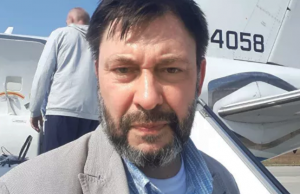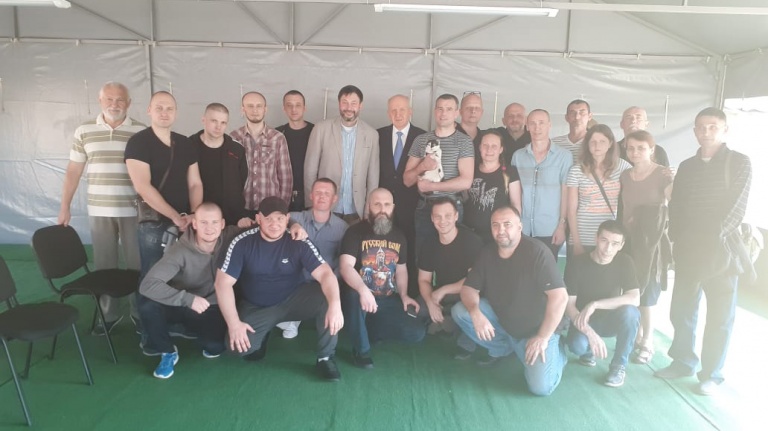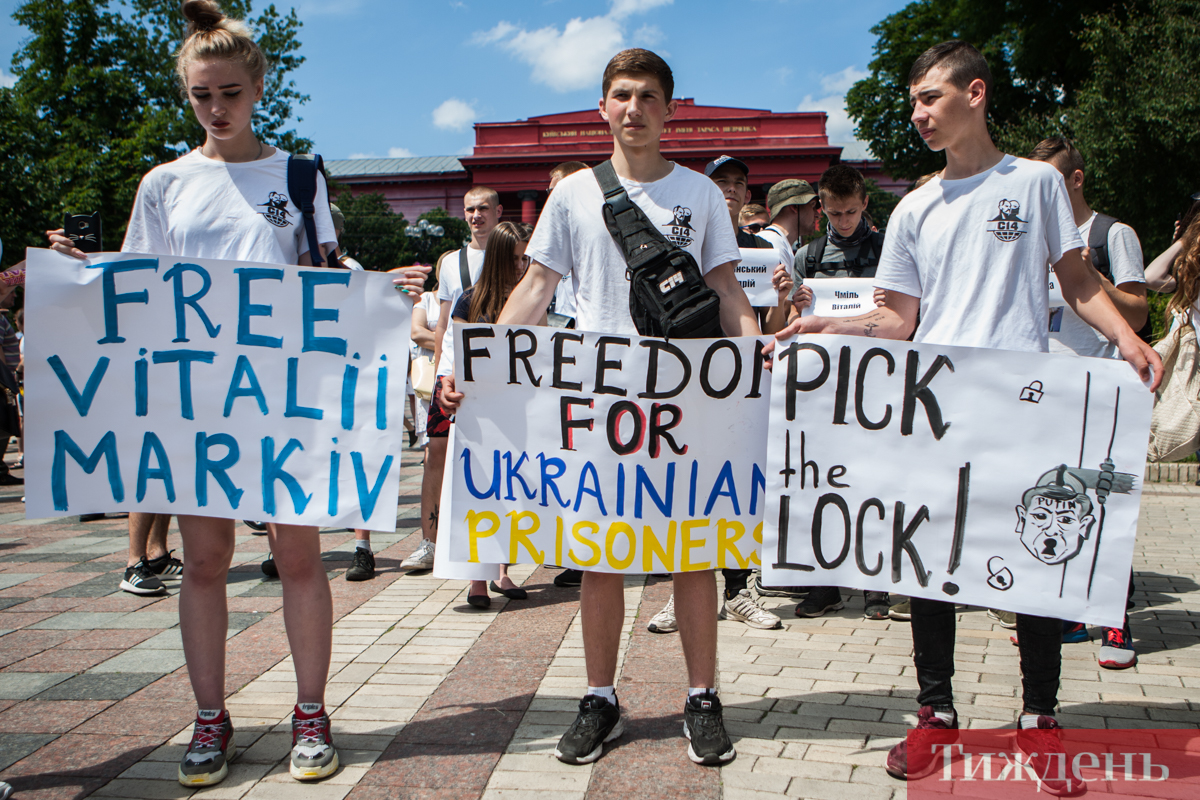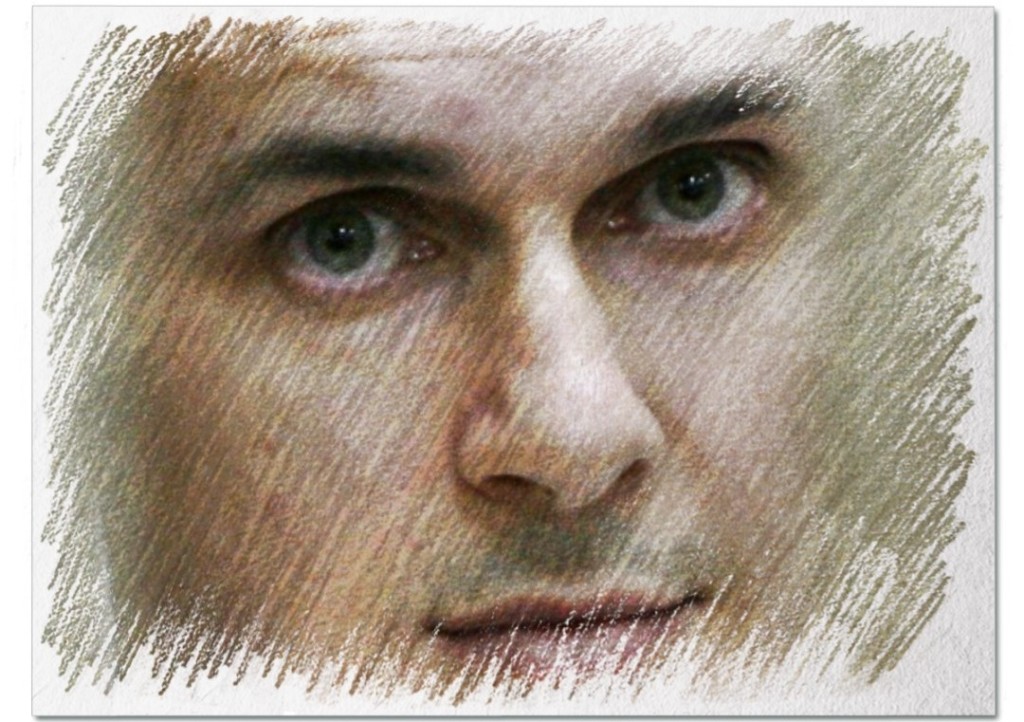For Ukraine, the Ukraine-Russia prisoner swap on 7 September was euphoric and touching. 35 men, of them 11 Ukrainian political prisoners of the Kremlin and 24 sailors Russia captured after attacking Ukrainian ships in the Black sea in November 2018, were greeted in Boryspil airport near Kyiv not only by their sobbing families but by the country at large - the event was the major news of the day. Hats went off to President Zelenskyy as having achieved a major breakthrough in the question of freeing Ukrainian political prisoners jailed by Russia and even in Ukraine-Russia relations.
But in Moscow, a different picture was observed - the (reportedly) 35 persons Russia received in exchange stepped from the airplane onto an empty concrete field. The only one who attracted media attention was Kyrylo Vyshynskyi, head of the Russian state media agency RIA Novosti. The difference in the two receptions was obvious:
Ukrainians had received back heroes, like Oleg Sentsov, the filmmaker who opposed the Russian occupation of his native Crimea and who launched a 145-day-long hunger strike in a Russian prison, demanding to free all the Ukrainian political prisoners of the Kremlin (of whom at least 86 still remain behind Russian bars). Ukrainian society had rallied for them and pressured the Ukrainian leadership to secure their release. The Russians had received an MH17 witness, a key Russian propagandist, and approximately 33 other no-namers.
The exchange process was remarkably opaque. There are still no clues as to why there is only one Crimean Tatar among the lucky prisoners to return to Ukraine, Edem Bekirov, if Crimean Tatars make up most of the list of the Ukrainian political prisoners, being arrested in droves in occupied Crimea. The question of whether it was wise to include the 24 Navy sailor POWs in the list, who, according to lawyer Nikolai Polozov, who coordinates the group of lawyers defending them, Russia would have been forced to release them in accordance with the decision of the UN Maritime Tribunal sooner or later, is still in the air. Doubts over Zelenskyy’s strategy overall, when Putin can imprison an unlimited amount of Ukrainians to use as bargaining chips to trade for political deals or for his agents in Ukraine, persist.
And it is still unclear who Ukraine actually handed over to Russia.
Although they have been widely depicted as “35 Russians” in the press, in fact, most are probably Ukrainians. Russian officials have not published their names. Various Ukrainian outlets have managed to obtain their own lists, which, however, differ from each other - probably, they are sourced from different officials at different stages of the negotiation process. The online media Novynarnia has compared all the lists and elaborated one that seems most reasonable. It contains 35 people, from whom 9 are Russian citizens, 16 are Ukrainian citizens, one is a Moldavian, and 9 have dual Russian-Ukrainian citizenship which is not allowed by Ukrainian law.
According to approximate estimates, the list contains:
- 13 spies
- 8 militants
- 4 deserters and those having committed state treason from Crimea
- 4 spy-traitors, participants of the Odesa “Antimaidan”
- 3 terrorists and murderers
- 1 propagandist
- 2 no data
The ones having received sentences were pardoned by Volodymyr Zelenksyy, those still under trial will presumably have their questioning continued. The legal side of the exchange gives cause for worry, as Ukrainian courts appear to have made decisions to release the accused from custody in response to orders from the President’s Office. Some of those released from custody in Ukraine did not travel to Russia in the end. Their whereabouts are unknown.
However, this does not mean that all the 35 on the presumed list were actually transferred to Russia. There is still no confirmation of who exactly Russia received.
Kyrylo Vyshynskyi, born 1967, citizen of Russia and Ukraine

Lawyer Nikolai Polozov believes that two people were key for Russia in order to release Sentsov and the 34 others, after a long period of refusing to having to have any dialogue on the matter with the administration of ex-President Poroshenko. Vyshynskyi is one of them.
Vyshynskyi was the head of RIA Novosti Ukraine, a branch of the Russian propagandistic state agency RIA Novosti. Ukraine’s Security Service accused the Dnipro-born journalist of creating a a subversive pro-Russian information network on the territory of Ukraine and treason.
According to the Myrotvorets website, which crowdsources information on pro-Russian subversion against Ukraine, in the spring of 2014, Vyshynskyi worked in Crimea where he together with his team of journalists created materials justifying the occupation of the Ukrainian peninsula by Russia. For this, Vyshynskyi was awarded the award of the Russian Federation "For the return of the Crimea" by a decree of President Putin. He was also awarded the Russian Medal of Merit for the Fatherland.
Vyshynskyi was detained on 15 May 2018 after searches in the Kyiv office of RIA Novosti and a criminal case was opened under article 111 of Ukraine’s Criminal Code (state treason). A Russian passport and Russian medal “For the return of Crimea” were found in the office. Ukraine’s deputy head of the Ukrainian security service (SBU) claimed that Russia had transferred RIA Novosti EUR 53,000 per month through a fictitious Serbian company. Prosecutors point to the numerous anti-Ukrainian publications on RIA Novosti which Vyshynskyi had managed, and his correspondence with Moscow curators, who had given him ideological tasks. The publications are said to have legitimized Russia’s occupation of Crimea and the creation of the two puppet “republics” in eastern Ukraine, whitewashed Russian aggression against Ukraine and incited interethnic hatred. After his arrest, Vyshynskyi declared he was renouncing Ukrainian citizenship.
On 18 July 2019, while commenting Zelenskyy’s statement that the first step to the normalization of the dialogue between Russia and Ukraine could be Russia’s release of the 24 Ukrainian sailors, Putin’s press secretary Dmytro Peskov declared that Vyshynskyi’s return to Russia could be such a step. On 28 August, Vyshynskyi was released from the remand prison.
Russia’s rescue of Vyshynskyi, Polozov believes, was meant to send a signal to propagandists in Russia - that the state will vouch for them no matter what.
Volodymyr Tsemakh, born 1961, citizen of Ukraine

Tsemakh is the second of two persons Polozov believes Russia wanted to receive most of all from the prisoner exchange on 7 September. He also became the apple of discord between the Zelenskyy administration and The Netherlands - Tsemakh is an alleged accomplice of the downing of flight MH17, as a result of which 298 people were killed on 17 July 2014, most being Dutch citizens.
Tsemakh, a resident of Snizhne in Donetsk Oblast currently under control of the “Donetsk People’s Republic (DNR),” fought against the Ukrainian army as part the “DNR’s” Russian-separatist forces from 2014 to 2017. Being educated in the Poltava higher anti-aircraft missile command school, he was chief of Snizhne’s air defense unit.
The SBU captured Tsemakh deep in “DNR” territory and transported to goverment-controlled territory on 28 June 2019 in the result of a quite remarkable special operation, in the result of which one operative died and another had his leg amputated. He was arrested in Kyiv, but released from custody on 5 September, when preparations for the prisoner release were ongoing. According to SBU head Ivan Bakanov, Russia was agreeing to hold the exchange only if Tsemakh was included in the lists. However, head of the Joint Investigative Team probing the MH17 catastrophe Fred Westerbeke called upon the Ukrainian authorities to refrain from handing Tsemakh over to Russia, as he is a suspect in the MH17 downing an, as a “DNR” officer, could potentially give an importat testimony proving Russia’s role in the incident.
As well, Tsemakh knew the commanders of the “DNR” forces fighting around Snizhne, including those responsible for attacking Ukrainian airplanes, and could prove the role of the Russian military in the Donbas war. Moreover, he should answer to allegations of murdering Ukrainian servicemen. In video interviews found on the Ramen branch of the Russian “Rodyna” party, Tsemakh tells how his division took part in shooting at a column of the 30th mechanized brigade of the Ukrainian army from an anti-aircraft installation. Two were killed right away, two were probably wounded and killed by militants of Tsemakh’s division.
Although Zelenskyy claimed that Tsemakh was questioned by Dutch prosecutors before being sent off to Russia, something confirmed by the Dutch NOS TV channel, Dutch Foreign Minister Stefan Block admitted that the Dutch government regretted Tsemakh was exchanged, as it feared bringing him to responsibility would now be impossible.
In a bitter ironic twist of events, on 12 September, Tsemakh’s daughter announced on her VKontakte profile that she and her father were going home, meaning “DNR”-occupied Snizhne. Tsemakh was returning to the town from which he had been kidnapped in the SBU special operation.
- Read more: Ukraine arrests head of Snizhne anti-aircraft defense in summer 2014, possible MH17 case witness
The other prisoners Russia received are less notable.
Russian citizens
Viktor Ageyev, born 1995. Private first class Viktor Ageyev from the 22nd special operations brigade of GRU comes from the Russian Altai region sandwiched in between China and Kazakhstan. He was detained after servicemen of Ukrainian 93rd brigade liquidated a subversive group near the small village of Zholobok in Luhansk Oblast on 24 June 2017. Sentenced to 10 years in prison by the Novoaidar court.
Aleksandr Valekhidis, born 1955. Born in Lviv (Ukraine), Valekhidis lived in Murmansk (Russia), where he became a Russian citizen, but moved to Sevastopol (Crimea, Ukraine) after retiring. He was detained on 30 July 2014 in Lviv and accused of spying. Reportedly, Valekhidis tried to find out which SBU operatives were sent to the war zone in Donbas and transferred this data to a Russian curator.
Sergey Yegorov, born 1980. He fought against the Ukrainian army on the side of the Russian-backed militants in Donbas, was captured in April 2017 and sentenced to 10 years in prison.
Arkadiy Zhydkih, born 1967. A resident of the far-eastern Russian city of Yakutsk, Zhydkih joined the “Vostok “ battalion of the 2nd army corps of the “Donetsk People’s Republic.” He was captured in September 2015.
Igor Kimakovskiy, born 1972. He was detained by Ukrainian law enforcers in June 2015 in the Donetsk Oblast. According to the SBU, Kimakovskiy is an FSB agent who informed “DNR” militants of movements of the Ukrainian army and established the identities of Russian citizens fghting for the Ukrainian government. Kimakovskiy denies the charges and claims he was a volunteer on a humanitarian mission in Donbas. Kimakvskiy was included on exchange lists of prisoners in Donbas as part of the Minsk process, but Ukraine refused to exchange Russian citizens.
Olga Kovalis, born 1968; her husband Pavel Chernyh, born 1974. Kovalis and Chernyh were detained at a checkpoint near Mariupol in April 2015 and accused of espionage for the “DNR” and creating a terrorist spying group, and subsequently sentenced. Kovalis was also on exchange lists of Donbas prisoners.
Yevgen Mefyodov, born 1983. Mefyodov was first tried for actions aiming to overthrow the constitutional order and encroachment of the territorial integrity of Ukraine after his participation in the pro-Russian marches and clashes in Odesa, as well as for separatism and attempts to overthrow the government. He was still under trial when he was exchanged.
Aleksey Siedikov, born 1979. Sedikov fought along the militants of the Russian-backed “Luhansk People’s Republic.” He was taken captive in 2016. During interrogations, he admitted that the militants of his group provocatively fired at their own territory so it appeared that the Ukrainian army was targeting civilian locations: “We fired on our own, and on Ukraine. Two shells there, and two shells the other way.” In 2017, a Ukrainian court found Siedikov guilty of terrorism and sentenced hm to 11 years in prison.
Ukrainian citizens
Baslan Ashanov, born 1966,
a militant of the Russian puppet “Luhansk People’s Republic.”
Olena Bobova, born 1972. Valeriy Pikalov, Denys Khitrov, born 1977. Petro Melnychuk, born 1972 (a citizen of Moldova)
According to SBU data, the four created a spy network, recruited employees of strategic enterprises in southern Ukraine and gathered intelligence on movements of the Ukrainian Army. Bobova was named as the leader of this group. According to the SBU, she received training in a special GRU training camp in Crimea, after which she returned to mainland Ukraine. Bobova was also a participant of anti-Ukrainian rallies in Odesa in May 2014. The trial of the four was ongoing when they were exchanged on 7 September.
Andriy Vaskovskyi, born 1991. In 2018, SBU head Vasyl Hrytsak informed that a mole had been found and detained. Later, lawyers told that Vaskovskyi was the mole and that he had been caught photographing classified documents, TSN reported.
Stanislav Yezhov, born 1978. Yezhov, a translator of Ukrainian ex-Prime Minister Volodymyr Groysman, was detained by the SBU in December 2017 and accused of state treason - espionage and collaborating with Russian special services. Before that, Yezhov had worked in the Ukrainian embassy to the USA and the President’s Administration. The investigation claims Yezhov was recruited by Russian special services during a trip to St. Petersburg, gathered information on the activities of Ukrainian government structures and transferred them to Russia with the help of special equipment, emailing it to the user “Helen the beautiful.” Yezhov pled guilty, was sentenced to 3 years 28 days in prison, but the term was already extinguished by the time spent in pretrial detention. Nevertheless, Yezhov was still under custody at the moment of the exchange.
Mykola Yeriomin, born 1961. No information
Dmytro Korenovskyi, born 1972; Viktor Fedorov, born 1969. The two men were detained in Mykolayiv in June 2018. According to the investigation, they gathered information on movement of Ukrainian troops for curators in Russian special services, engaging former and acting servicemen. Both were accused of state treason and espionage.
Andriy Kostenko, born 1984. No information.
Oleksiy Lazarenko, born 1985. An agent of the Russian military intelligence who worked at a strategic enterprise in Zaporizhzhia, the MiGrepair aviation factory, providing Russia with secret information. He was detained in July 2019 while crossing the state border with a microSD card containing secret information of the Ukrainian aviation industry, and sentenced in August 2019 to nine years in prison on the accusation of state treason after pleading guilty. Ukrainian counterintelligence operatives found that Lazarenko was recruited by a GRU operative in Crimea to support ideas of the “Russian world” and gather information not only on Ukrainian aviation, but the general situation in Zaporizhzhia region, and was paid. Lazarenko transferred the data through electronic communication channels, as well as gave them to GRU operative during meetings in Russia, Belarus, and occupied Crimea.
Sergiy Lazarev, born 1957. In December 2017, the Ukrainian counterintelligence busted a GRU agent and a former high-ranking Ukrainian army officer. It turned out that he spied for Russia under the callsign “Socrat,” gathering intelligence on Ukrainian planes. After being arrested, Lazarev confessed that he always perceived Ukraine as a “branch of Russia,” which is why he started working for the aggressor country. His curator in the Russian intelligence was Denis Yushin. Russia was interested in a secret Ukrainian military aviation base and with Lazarev’s help tried to obtain one of the Ukrainian army’s most popular UAVs. Lazarev wanted to receive a Russian military pension and residence permit. He was sentenced to four years.
Yuliya Prosolova, born 1988. Prosolova, who lived in Donetsk, conducted a terrorist act on the territory of Ukrainian-government controlled territory on behalf of the “DNR” - In 31 March 2017, Oleksandr Kharaberiush, deputy chief of the main unit of the counterintelligence of the SBU’s Donetsk branch, died from an explosion of a detonation device that she planted in his car. In October 2017, the SBU detained Prosolova and in October 2018, she was sentenced to 12 years.
SBU chief Vasyl Hrytsak claimed that Prosolova worked in the so-called “special operations center of the Ministry of state security of the DNR,” which is coordinated by and financed by the Russian special services and headed by Vasiliy Yevdokimov. According to the SBU, Prosolova received $15,000 for this act. Commenting to TSN, Prosolova told that she is a drug addict and that she spent nearly $10,000 on drugs and entertainment.
The murder of Kharaberiush wasn’t her last task - a Ukrainian special services officer in Sloviansk was to be her next victim, and another terrorist act was to be implemented in Kurakhove, where a major power station is located.
Oleksandr Rakushyn, born 1963.
A Ukrainian Army reserve officer, Rakushyn was detained in June 2019. The investigation believes that the FSB recruited him in 2017, after which he gathered intelligence on Ukrainian arms, movements of military equipment and troops, attempted to recruit SBU officers. Ukrainian counterintelligence believes that the coordination of his activities was done through the “Ministry of state security of the DNR” and an SBU operative in Odesa Oblast.
Antonina Radionova, born 1969. A former employee of the Ukrainian National Guard, she started spying for Russia. According to the case materials, Radionova was recruited by the GRU in 2016 in Krasnogorsk and provided information about the National Guard to the Russians, including secret information on its capabilities of defense against radiation, chemical, and biological weapons. Radionova pled guilty and was sentenced to four years in 2018.
Oleksandr Tarasenko, born 1970. No data.
Persons with both Ukrainian and Russian citizenship
Oleksandr Baranov, born 1983: Maksym Odyntsov, born 1983. Baranov and Odyntsov both served in the 10th Brigade of Naval Aviation of the Ukrainian Navy in Saky, Crimea. After Crimea was occupied by Russia in 2014, they defected to the Russian army and received Russian passports. Baranov and Odyntsov were detained in 2016 at the crossing point to mainland Ukraine upon attempting to purchase falsified higher military education documents, which turned out to be an SBU operation. They were sentenced to 14 years for desertion and state treason.
Volodymyr Halychyi, born 1948. A former deputy of the city council of Sevastopol in Crimea, which voted in favor of the city joining Russia in March 2014. Halychyi received a Russian passport. He was detained in September 2015 at the administrative border between mainland Ukraine and occupied Crimea.
Serhiy Hnatiev, born 1988. A businessman living in Sevastopol, Hnatiev was found guilty of an attempt at murdering a pro-Ukrainian activist. Hnatiev had seen how the activist snatched off a St. George’s ribbon, a symbol of Russian imperialism, from a woman at a Victory Day celebration in Kyiv. Hnatiev traveled to Kyiv and stabbed the activist, who miraculously survived. He was sentenced to eight years in prison.
Yuriy Lomako, born 1961. A captain of the Ukrainian Navy in reserve, and former chief of an arsenal of mine-torpedo and trawling weapons, Lomako managed a network of the Russian special services in the Mykolayiv Oblast where he gathered intelligence on Ukrainian army units and formed subversive groups. In 2019, he was sentenced to five years in prison.
Oleksandr Sattarov, born 1980. A member of the Berkut riot police, Sattarov took part in capturing Ukrainian military bases during Russia’s occupation of Crimea as part of the so-called “people’s militia of Crimea” and received awards from the occupation authorities. He was placed on the wanted list, detained in 2017 and put on trial under the accusation of encroaching upon the territorial integrity of Ukraine.
Taras Synychak, born 1977. A military medic in Crimea, Synychak defected to Russia after the occupation and did not retreat to mainland Ukraine. Instead, he received a Russian passport and started working for the Russian army. He was sentenced to eight years in prison for state treason. According to a report by Graty, Synychak did not depart to Moscow despite being on the list; his lawyer told that the military medic is in Ivano-Frankivsk under house arrest, considers himself a citizen of Ukraine, denies his guilt, and does not want to be given to Moscow.
Hybrid war alarm
In the rightful jubilation after the return of the Ukrainian political prisoners and sailors back home, many dismissed concerns of critics of this unequal exchange, claiming that the lives of Ukrainian citizens in Russian captivity are priceless, and Russia received a bunch of terrorists and criminals Ukraine did not need anyway, therefore, Ukraine only won.
While the first part of the claim can hardly be disputed, the second is a dangerously frivolous assertion.
As revealed by the Surkov Leaks, a major dump of emails of the Kremlin’s top advisor Vladislav Surkov, it were Ukrainian ideological collaborators who were key for Russia’s hybrid war in Ukraine. They knew the ins and outs of the Ukrainian political and societal landscape. They had the connections, and, most importantly, the desire to destroy Ukrainian statehood from within for the benefit of the “Russian world.”
One such ideological collaborator, an Odesa Antimaidan activist Anton Davidchenko, escaped to Russia after being released from custody by a Ukrainian court. He then became one of the chief field officers of Russia’s war against Ukraine, and for the two years we are able to observe in the Surkov Leaks, curated groups of foot soldiers that called for a Russian invasion, demonized the Ukrainian authorities, incited mass unrest and dissatisfaction with the government, and led campaigns for the federalization of Ukraine.
Such actions are the basis of the Kremlin’s political subversion of Ukraine, and they are impossible to conduct without such collaborators.
Zelenskyy’s opaque exchange, although providing a long-awaited release for the 35 Ukrainians, as well as a popularity boost for his persona, gave Russia a small army of these ideological collaborators, who, willingly or under the pressure of Russia’s special services, are sure to find themselves a role in Russia’s covert war against Ukraine.
And that brings about a nagging question which for many darkens the joy of the long-awaited return home of the lucky 35: what is the price that Ukraine will ultimately pay for this exchange?





